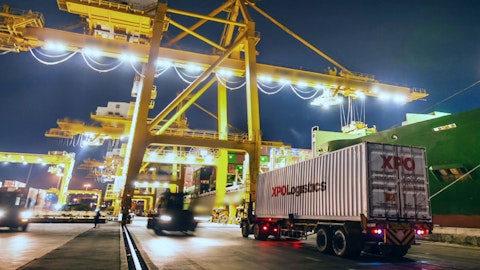XPO Logistics (NYSE:XPO) shares are down around 50% due to some headwinds. XPO has been a rollup, buying logistics companies and integrating them to capture the benefits of scale and efficiency. The stock fell after the fourth quarter due to the news that Amazon may have diverted its business ‘in-house’ or to elsewhere. Amazon may have been XPO’s largest customer. Now that the stock has settled down, let’s see if the stock presents an opportunity or not. Let’s also analyze hedge fund sentiment around the stock.
Why do we pay any attention at all to hedge fund sentiment? Our research has shown that hedge funds’ large-cap stock picks indeed failed to beat the market between 1999 and 2016. However, we were able to identify in advance a select group of hedge fund holdings that outperformed the market by 32 percentage points since May 2014 through March 12, 2019 (see the details here). We were also able to identify in advance a select group of hedge fund holdings that’ll significantly underperform the market. We have been tracking and sharing the list of these stocks since February 2017 and they lost 27.5% through March 12, 2019. That’s why we believe hedge fund sentiment is an extremely useful indicator that investors should pay attention to.
In terms of elite fund activity, Zachary Sternberg And Benjamin Stein’s Spruce House Investment Management was bullish in Q4 raising its stake by 65% to 12.75 million shares at the end of December. That position made up around 33.48% of the fund’s equity portfolio according to 13F documents. Michael Kahan And Jeremy Kahan’s North Peak Capital also established a new position of 279,507 shares according to data concerning the same time period. Sims Lansing’s Lansing Management established a new position of almost 150,000 shares for Q4 too.
In terms of the company, XPO is a top ten logistics company worldwide with around $17 billion in sales. The company has two segments, transportation and logistics. The former accounts for around 65% of sales while the latter accounts for the rest. Around 59% of XPO’s sales are generated in the United States. France accounts for 13%, and the United Kingdom accounts for 12%.
For the fourth quarter, XPO reported a rise in sales of $4.39 billion versus $4.19 billion in Q4 a year ago. XPO experienced 5.4% organic sales growth and the company generated $479 million of free cash flow, versus $210 million in the quarter a year ago.
XPO was originally priced for a lot of growth, but now that growth is uncertain due to the Amazon news. XPO is a buyback story now, as it has a big buyback program versus its market cap.
On February 4, 2019, XPO completed a $1 billion buyback program, retiring 18 million common shares at an average price of $56.09 per share. XPO seems committed to buying back more stock as its board authorized a new share repurchase program on February 13, 2019 of up to $1.5 billion.
As for XPO’s 2019 financial targets, the company sees organic revenue growth of 4-6% year over year, total sales growth of 3-5%. Management sees free cash flow in the range of $525-$625 million, down from the prior target of $650 million. Management sees adjusted EBITDA of $1.65-$1.725 billion, an increase of 6%-10% year over year, versus the previous target of 12% to 15%. That’s not a lot compared to what some bulls were expecting.
Of particular interest is that XPO is the largest last mile logistic provider for heavy goods in the North American continent, a fast growing $13 billion sector that’s estimated to grow 3x-5x GDP.
Like cars which is set for disruption due to electric vehicles and self driving tech, logistics is set for disruption. XPO has for example invested in technology to deploy autonomous mobile robots that collaborate with humans by lifting inventory storage racks and help carry them to picking stations. The robots shorten order-to-shipment durations, helps make next-day and same-day deliveries possible, and minimizes manual errors. XPO also uses sophistics analytics for demand forecasting and drones for inventory management.
E-commerce is a big tailwind for the last mile, and within e-commerce, there is a shift towards buying heavier and larger items, and given XPO’s specialization in that field, the trend is a potential advantage for the company.
Analysis
Relative to UPS and FedEx, XPO is rather small. The smaller scale will make XPO more vulnerable to competition from a company like Amazon. Amazon is a challenge. Amazon has signaled that it wants to play a part in the shipping of parcels industry and when Bezos’ company wants to do something, it will likely give existing companies a good challenge.
By in-housing the delivery of parcels, Amazon could potentially save $2-$4 per package, have better control over the crucial ‘last-mile’ delivery that could potentially allow Amazon to deliver faster than its competitors, and ensure that any shipping disruptions that occurred in December 2013 is a minimum.
We think the Amazon threat is credible long term. Amazon has hurt retail stocks, book seller stocks, and the logistics market could be next in terms of Amazon getting market share.
XPO seems like a wait and see stock to us even though there is an opportunity. The stock is cheap but its forward earnings multiple is similar to FedEx, which is arguably is in much better position to defend against Amazon.
Disclosure:none




